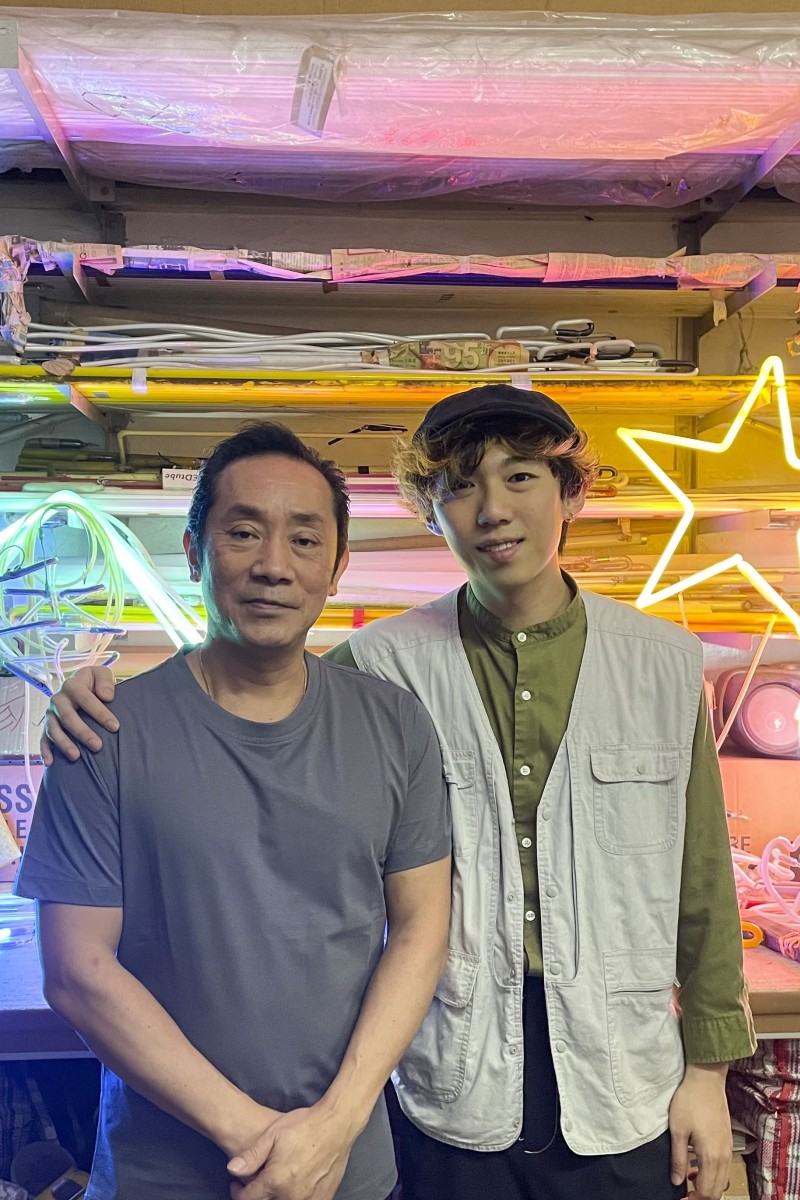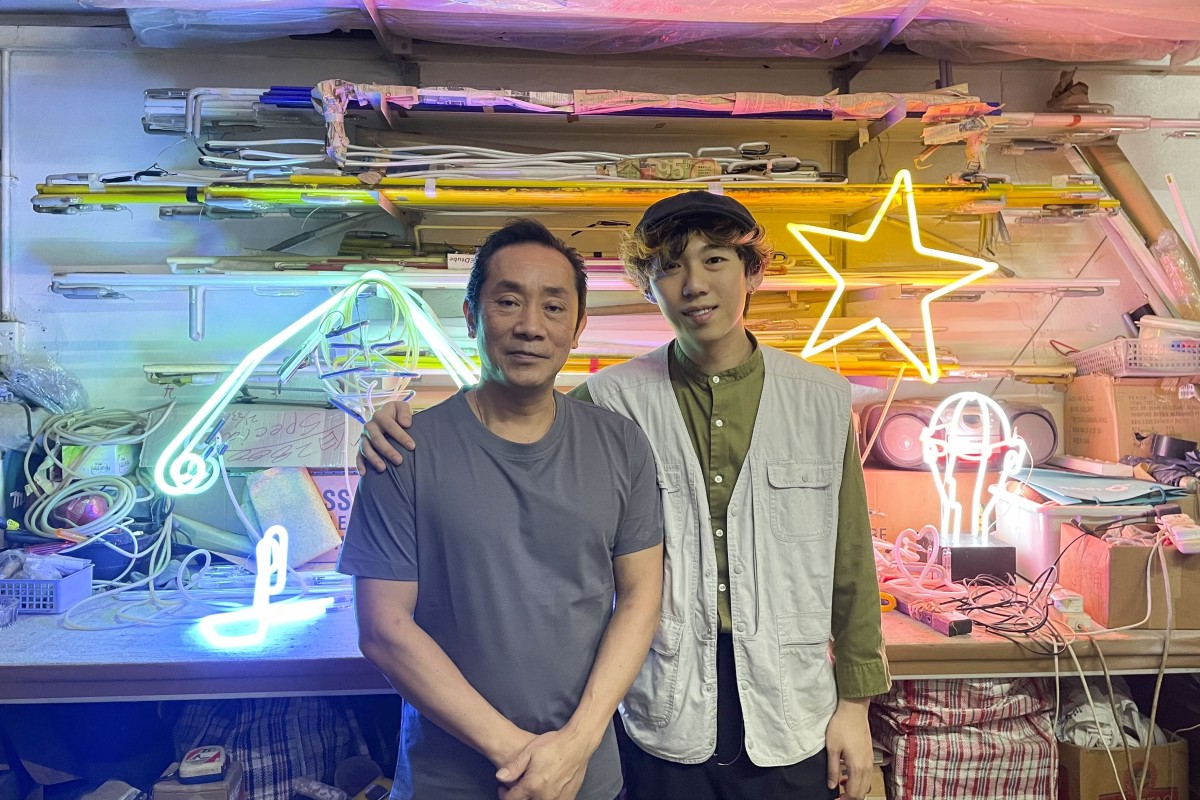
Neon master and actor he trained for A Light Never Goes Out cast light on Hong Kong’s fading neon sign industry
- Wu Chi-kai, one of about eight neon light craftsmen left in the city, passed on his skills to Henick Chou, who played an apprentice to a master neon sign maker
- Released in Hong Kong earlier this year, the film directed by Anastasia Tsang made waves for being a nostalgic love letter to the city’s neon-lit past
 Wu Chi-kai (left) says he was surprised by Henick Chou’s dedication to learning his craft. Photo: Yanni Chow
Wu Chi-kai (left) says he was surprised by Henick Chou’s dedication to learning his craft. Photo: Yanni ChowSome 30 years ago, Wu Chi-kai – 18 at the time – took a temporary job making neon signs at his father’s company just to do something useful with his summer.
“At first, it was really just a summer job, nothing permanent, but the boss wanted more young faces to join the industry,” the 56-year-old craftsman recalled.
Thirty-eight years later, Wu has stayed in the industry, watching as government rules and new technology have made Hong Kong lose many of its famous neon signs.
“When you walked ... along Nathan Road, you used to see all these signs sticking out vertically or horizontally screaming for attention. That kind of scenery is of course nowhere to be found these days,” the master lamented.
The disappearing icons of Hong Kong, from dai pai dongs to neon signs
In the craft’s heyday, Wu said there were 30 to 40 masters. Now, he is one of about eight left.
But recently, Wu had the chance to see his craft preserved on the big screen and to pass on his skills to an unlikely student – 27-year-old actor Henick Chou, who was preparing for his role as an apprentice to a master neon sign maker in A Light Never Goes Out.
Released in Hong Kong earlier this year, the film directed by Anastasia Tsang made waves for being a nostalgic love letter to the city’s neon-lit past.
Reflecting on his experience learning from Wu, Chou shared: “I really like the relationship between a master and his apprentice, it’s more tight-knit ... and that’s how legacies pass on to future generations.”
Blast from the past
When Wu was first learning the trade, he would stand in the workroom from 9am until 6pm, torching glass tubes until they could be bent into words and shapes. Then, the tubes would be infused with gases such as neon, argon and helium to produce signs of different colours.
“Actually, that is quite boring to a teenager, but I didn’t seem to mind,” Wu said of his long hours cooped up in the workspace. “Maybe that is why I could master the craft.”
These blazing neon signs used to blanket almost every neighbourhood of Hong Kong, transforming the city’s night sky into a kaleidoscope of bright hues. In the 1980s, when the city’s economy was thriving, the neon light industry was buzzing as shops wanted eye-catching facades to attract business.
Without instant messaging, people back then decided where to meet using neon signs as landmarks, Wu said.
Hong Kong’s young ‘neon nomads’ keep dying trade flickering
But over time, the traditional craft has been slowly replaced with cheaper plastic sign boards or LED lights.
After incidents in which ageing signboards fell on pedestrians, government regulations put together in 2010 have caused the number of neon signs to dwindle further.
Under those rules, all existing signboards were made illegal unless they complied with new standards on size and placement. The Buildings Department said an average of about 3,300 signboards had been “removed or replaced” annually between 2018 and last year.
Thus, A Light Never Goes Out, with its montages revisiting the cantilevered neon lights above bustling Hong Kong streets, struck a chord with Wu.
In one scene, the widow – played by Sylvia Chang who was named best actress at the Golden Horse Awards for this role – asks why the government is removing her husband’s signs after they have safely stood for years.
Wu reflected: “Now that I look back, I kind of regret why we didn’t persevere at first and voice out to the government: [we should] keep the old existing [signs], but we’ll make new ones ... adhering to the new regulations.”
“The film should’ve been aired 10 or 20 years earlier, right about the time when the regulations first appeared.”
Hot Topics: What is the future of Hong Kong’s neon signs?
A sign of things to come
Since its release, the heartwarming film has rekindled attention towards the vanishing craft.
Even Chou, born in an era when Hong Kong’s neon lights were already fading, admitted he had not paid much attention to these signboards until acting in the movie.
“My only perception of them was that neon lights are beautiful but what a shame they are being taken down. It wasn’t until I filmed the movie that I learned more,” he said, explaining how learning from Wu helped him develop respect for this profession.
“I seldom do handicrafts and that process [of learning] brings an immense amount of satisfaction,” Chou noted.
Even Wu was impressed by the actor’s dedication: “He would ask me if the tubes were bent correctly instead of only being concerned if his gestures were convincing to the audience.”
In the film, Leo – played by Chou, who, for this role, was nominated for best new performer at the 41st Hong Kong Film Awards – decides to dedicate his life to making neon lights. One of the character’s final scenes also helped the actor reflect on his passion in the real world: acting.
Near the film’s end, Leo has a graduation ceremony after fulfilling his master’s wish to make one last neon sign.
The scene held another layer of meaning for Chou, as this was his first major film as a leading actor. “To me, acting has no graduation ... but [this scene] is the closing of a significant chapter for me,” he said.
As Chou looked forward to future endeavours in his career, Wu looked back at how his job has changed.
The art of preserving old Hong Kong: one artist’s quest to honour sunset trades
“At one point, when the work started to pile high ... [we] would sleep in the studio after working until midnight, and keep working right after we woke around 8am. We didn’t go home for almost two weeks,” Wu recalled.
“Now, I’m so much freer. In the old days, I was waiting for time to rest, but now, I’m waiting for work.”
Still, he is not too pessimistic.
“I knew when I joined the industry that nothing stays forever, and I might not be able to do this for the rest of my life,” Wu shared, adding that recent orders were usually from artists. “I learned to accept the change, so actually, I wasn’t too sad about all this.”
Even if the city is not what it used to be, Wu is reminded that neon lights are a symbol of something everlasting. He said: “Unlike LED lights which you can change often, once [neon lights] are made, it will always stay that way.”
Apprentice 學徒
a young person who works for an employer for a fixed period of time in order to learn the particular skills needed in their job
Apprentice 學徒
a young person who works for an employer for a fixed period of time in order to learn the particular skills needed in their job
Tight-knit 關係緊密
(of a family or community) with all the members having strong, friendly relationships with one another
Argon 氬
a chemical element. Argon is a gas that does not react with anything and is used in electric lights
Kaleidoscope 千變萬化
a situation, pattern, etc. containing a lot of different parts that are always changing
Hues 色調
a colour; a particular shade of a colour
Montage 蒙太奇
a picture, film or piece of music or writing that consists of many separate items put together, especially in an interesting or unusual combination
Cantilevered 懸桁
(of a projecting beam or structure) fixed or supported at only one end
